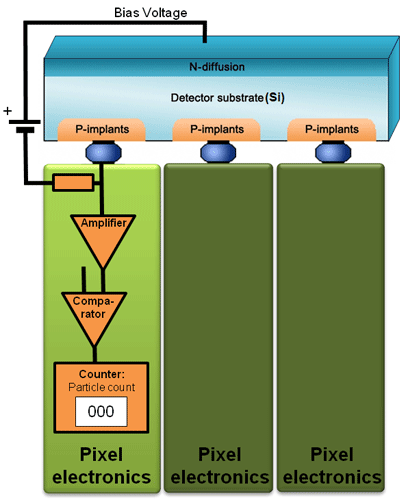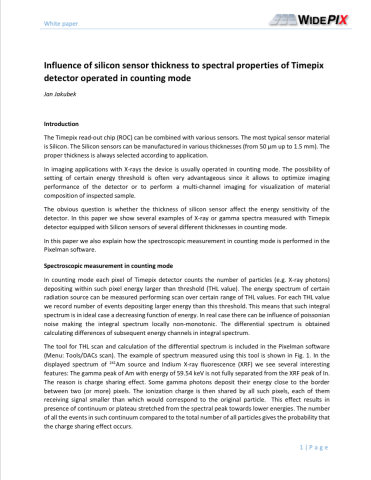Photon counting imaging detectors
It was already explained in the section X-ray radiographic system that the photon counting detectors are as important step in X-ray imaging as were colour films in photography. But how does such detector work?
First of all it consists of two parts: the sensor and readout chip. The sensor is a pixelated reversely biased diode. Each pixel of the sensor is connected to a corresponding electronics in the readout chip.

The principle of photon counting: the sensor pixels (a reversely biased diodes) are connected to the pixel electronics in the readout chip.
A quantum of radiation that hits the sensor creates charge which is collected to an appropriate pixel electrode. This charge pulse is amplified and conducted to a comparator. The comparator checks if the signal is above a certain level. If yes then a counter in the pixel is increased. The amplitude of the pulse that comes from the sensor is proportional to the energy of the incoming quantum (photon). Therefore, there is a direct relation between the threshold level set in the comparator and energy of the incoming radiation. The energy spectrum of the incoming radiation beam can be then measured by scanning with the comparator level and therefore measuring radiation intensity at different energy levels.
Appart from the signal processing electronics, the pixel contains also circuitry for reading out the data when measurement is over and setting up different chip parameters and modes. The Timepix readout chip which is the heart of most cameras presented here has in addition to the photon counting mode also mode where the overall energy of radiation is measured directly (Time-over-Threshold mode). Only one particle per pixel and frame exposition could be measured in this mode and therefore is more suitable for particle tracking applications and X-ray fluorescence detection and less for the transmission imaging. The pixel electronics supports also mode of operation where the time of radiation arrival is measured. This mode is also more suited for applications at accelerators where other particles than photons are detected. Setting up all of these parameters is taken care of by the software in a computer that controls the whole camera.
Different energy ranges and types of radiation require also different sensors. You can read more about the sensor technology in the next article.



